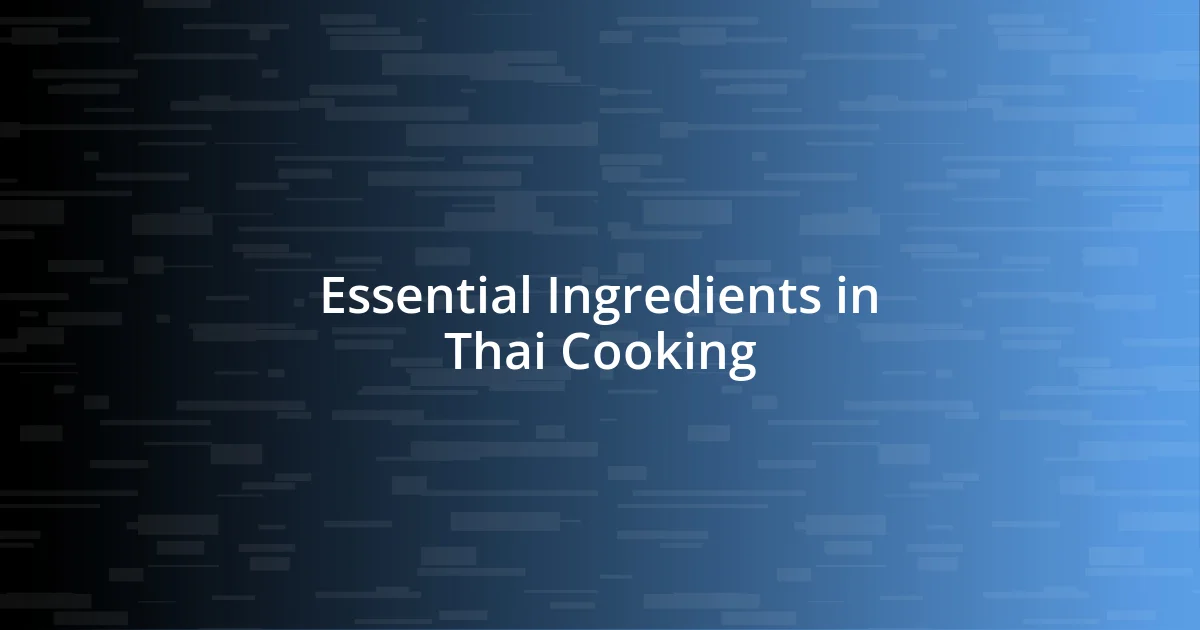Key takeaways:
- Thai cuisine is characterized by a harmonious balance of sweet, sour, salty, and spicy flavors, illustrated by dishes like Som Tum and Pad Thai.
- Essential ingredients, such as lemongrass, galangal, and fish sauce, are crucial for achieving the distinctive tastes of Thai cooking.
- Experiences in street food markets and cooking classes highlight the cultural significance of food, fostering community and connection through shared culinary practices.

Introduction to Thai Cuisine
Thai cuisine is a vibrant tapestry of flavors, textures, and aromas that truly reflect the country’s culture and history. I still remember the first time I walked into a bustling street market in Bangkok, the air filled with the intoxicating scent of lemongrass and chili. Have you ever wondered what makes Thai food so distinctive and delightful?
One of the fascinating aspects of culinary adventures in Thailand is the harmonious balance of sweet, sour, salty, and spicy—often within the same dish. For instance, the tangy explosion of papaya salad (Som Tum) paired with the sweetness of palm sugar is nothing short of a revelation. It’s like a symphony for your taste buds, inviting you to savor each note.
As I navigated through countless food stalls, each vendor proudly offered their unique spin on classic dishes, underscoring the creativity and regional diversity of Thai fare. The vibrant colors and intricate presentations seemed to tell a story, almost as if each plate held a piece of personal history. Don’t you think that food has an uncanny way of connecting us to places and experiences in profound ways?

Essential Ingredients in Thai Cooking
When I think of Thai cooking, certain ingredients immediately spring to mind. Each one plays a vital role in creating that signature flavor profile that keeps me craving more. For example, fresh herbs like basil and cilantro lend a brightness that cuts through the richness of coconut milk. I recall sitting outside a small restaurant in Chiang Mai, where they tossed fragrant basil into a hot wok, filling the air with an aroma that transported me to another world.
Here’s a quick rundown of essential ingredients that you’ll encounter in many Thai dishes:
- Lemongrass: Adds a fresh, citrus flavor and aroma.
- Galangal: A close relative to ginger, offering a warm spiciness.
- Thai chili: Provides that necessary heat, varying from mild to fiery.
- Fish sauce: Acts as a key seasoning, bringing umami depth.
- Kaffir lime leaves: Infuse dishes with a bright, zesty note.
- Palm sugar: Balances flavors with its unique sweetness.
- Coconut milk: Creamy and rich, it enhances the texture and flavor of many curries.
These ingredients are not just components; they’re storytellers of Thailand’s culinary narrative. Every time I combine them in my own kitchen, I feel like I’m recreating a small piece of my adventures—savoring the thrill of replicating those tastes while reminiscing about the vibrant streets of Thailand.

Popular Thai Dishes to Try
When diving into Thai cuisine, a select few dishes truly capture the heart of this culinary gem. For instance, Pad Thai is a quintessential street food staple that I eagerly devoured during my travels. Picture thick rice noodles stir-fried with shrimp, tofu, and bean sprouts, all brought together by a savory tamarind sauce. The aroma of lime and crushed peanuts sprinkled on top took my taste experience to a new level. Have you ever found yourself craving a dish that reminds you of a specific moment in time? That’s how Pad Thai felt for me—a delicious memory.
Another dish worth noting is Tom Yum Goong, a hot and sour shrimp soup that bursts with flavor. I recall savoring this soup at a quaint seaside restaurant, each spoonful highlighting the freshness of the shrimp along with a zesty kick from lemongrass and kaffir lime leaves. It was one of those rare moments when the meal was so good it made me forget the world, as I got lost in the vibrant heat that danced on my palate. Do you believe that food can create such moments of bliss and escape? For me, Tom Yum Goong does exactly that.
Lastly, I can’t talk about popular Thai dishes without mentioning Green Curry. I remember my first encounter with it at a local eatery tucked away in a Chiang Rai alley. The rich, creamy coconut milk combined with the spiciness of green chilies enveloped tender chicken pieces and eggplant. It left me in awe, as each bite sent waves of warmth and comfort through me. It’s a dish that embodies the comforting embrace of Thai home-cooking, making it a must-try for anyone exploring the depths of Thailand’s culinary landscape.
| Thai Dish | Flavor Profile |
|---|---|
| Pad Thai | Savory, slightly sweet, tangy |
| Tom Yum Goong | Spicy, sour, aromatic |
| Green Curry | Spicy, creamy, rich |

Street Food Experiences in Thailand
Street food in Thailand is like an unfiltered window into the heart of its culture. One evening in Bangkok, I stumbled upon a bustling food market where vendors showcased their specialties. The sizzle of grilling skewers wafted through the air, beckoning me. Watching a vendor expertly whip up satay—skewered meat grilled to perfection and served with a peanut sauce—made me appreciate how food can connect us with our surroundings. Have you ever felt so drawn to a dish that it felt like you were sharing a secret with the chef? That was my experience.
Tasting the vibrant street food is more than just a meal; it’s an adventure. The first bite of a freshly made mango sticky rice stopped me in my tracks—I could feel the sticky sweetness coating my tongue, balanced by the rich coconut milk. The joy I felt is something I find hard to describe; it was like discovering a new favorite song that resonates with my soul. Have you ever had a food experience that felt spiritual? This was mine, reminding me that sometimes, the simplest foods can leave the deepest impressions.
Another memorable moment unfolded in Chiang Mai as I savored a bowl of Khao Soi, a creamy coconut curry noodle soup. I fondly remember the warmth wrapping around me on a cool evening, each spoonful transporting me back to that little shop where the owner greeted everyone with a smile. The combination of crunchy onions, crispy noodles, and that rich broth created a symphony of flavors. It made me wonder—how often do we rush through meals, missing the chance to enjoy each bite fully? In Thailand, I learned to slow down, embrace the moment, and truly savor what’s on my plate.

Cooking Classes and Workshops
Taking a cooking class in Thailand was an eye-opening experience for me. I recall stepping into a vibrant kitchen in Chiang Mai, surrounded by fresh ingredients and eager participants. Engaging with local chefs not only taught me the art of balancing flavors but also revealed the stories behind each dish. Have you ever learned something that changed the way you view food? For me, it was understanding how Thai cooking is built on harmony, a theme I hadn’t truly appreciated before.
One particular workshop became a highlight of my trip. I learned to make my own curry paste, a task that felt both empowering and humbling. The aroma of freshly ground spices filled the room, enveloping me in a warm embrace as I pounded garlic, chilies, and galangal together. The hands-on approach made me reflect—how often do we get so caught up in convenience that we forget the joy of creating from scratch? That moment taught me not just about flavors but also the importance of mindfulness in the cooking process.
What surprised me was how cooking classes also foster a sense of community. I remember sharing a meal at the end of one session with newfound friends from around the world. We laughed over our culinary blunders and celebrated each other’s successes. It brought to mind the question: Isn’t it fascinating how food can bring strangers together? This experience deepened my understanding of Thai culture and reinforced my love for cooking as a universal connector.

Tips for Authentic Thai Cooking
When it comes to authentic Thai cooking, using fresh ingredients is paramount. I remember visiting a local market where the colors of fruits and veggies were so vibrant they made my heart excited. Choosing ripe tomatoes and fragrant herbs reminded me of the connection between food and quality. How often do we underestimate the importance of freshness in our meals? In Thai cuisine, using the best ingredients elevates every dish to a whole new level.
Another essential tip I picked up is mastering the balance of flavors. Thai food is known for its harmonious combination of sweet, sour, salty, and spicy elements. During one memorable cooking session, I found myself experimenting with the perfect ratio of tamarind paste to palm sugar in a dipping sauce. That moment was exhilarating! It made me realize—how often do we taste our food before serving it? Tasting in the moment not only enhances the flavor but also deepens our connection to the cooking process.
Lastly, don’t shy away from using traditional tools like the mortar and pestle. I distinctly recall struggling with grinding spices during a class and feeling a sense of triumph when I finally achieved that fragrant paste. The physicality of it reminded me of the appreciation we often overlook. Have you ever felt a sense of accomplishment from doing things the old-fashioned way? That tactile experience truly brought the dishes to life and allowed me to connect more intimately with Thai culinary traditions.

Exploring Regional Thai Flavors
Exploring the regional flavors of Thailand took me on a delightful culinary journey, each bite revealing a unique tradition. In southern Thailand, I encountered the bold and spicy curries infused with coconut milk, like the iconic Massaman curry I savored in a local eatery. I can still taste the warmth of spices dancing together—have you ever tasted something so wonderful it lingers in your memory? It made me appreciate how geography influences food; the richness of the south truly is a feast for the senses.
While I ventured to the north, I discovered a contrast in flavors—with dishes like Khao Soi, a creamy and tangy noodle soup. The blend of crispy and soft noodles, with a touch of lime, gave me an unexpected push and pull of textures. I remember slurping that bowl with sheer joy and thinking, how could just one dish encapsulate a whole culture? This experience drove home the importance of region in Thai cuisine; every spoonful told a story of the land and its people.
Then, in the northeast, I was introduced to the refreshing and zingy salads like Som Tum, made with green papaya and peanuts. I couldn’t believe how a simple salad could bring such an explosion of flavors! Eating it under the shade of a tree, I realized how every dish, whether fiery or mild, reflects the local climate and ingredients. It struck me then—how many of us truly connect our meals to their origins? Every flavor I encountered further ignited my passion for exploring the diverse culinary tapestry that Thailand has to offer.














